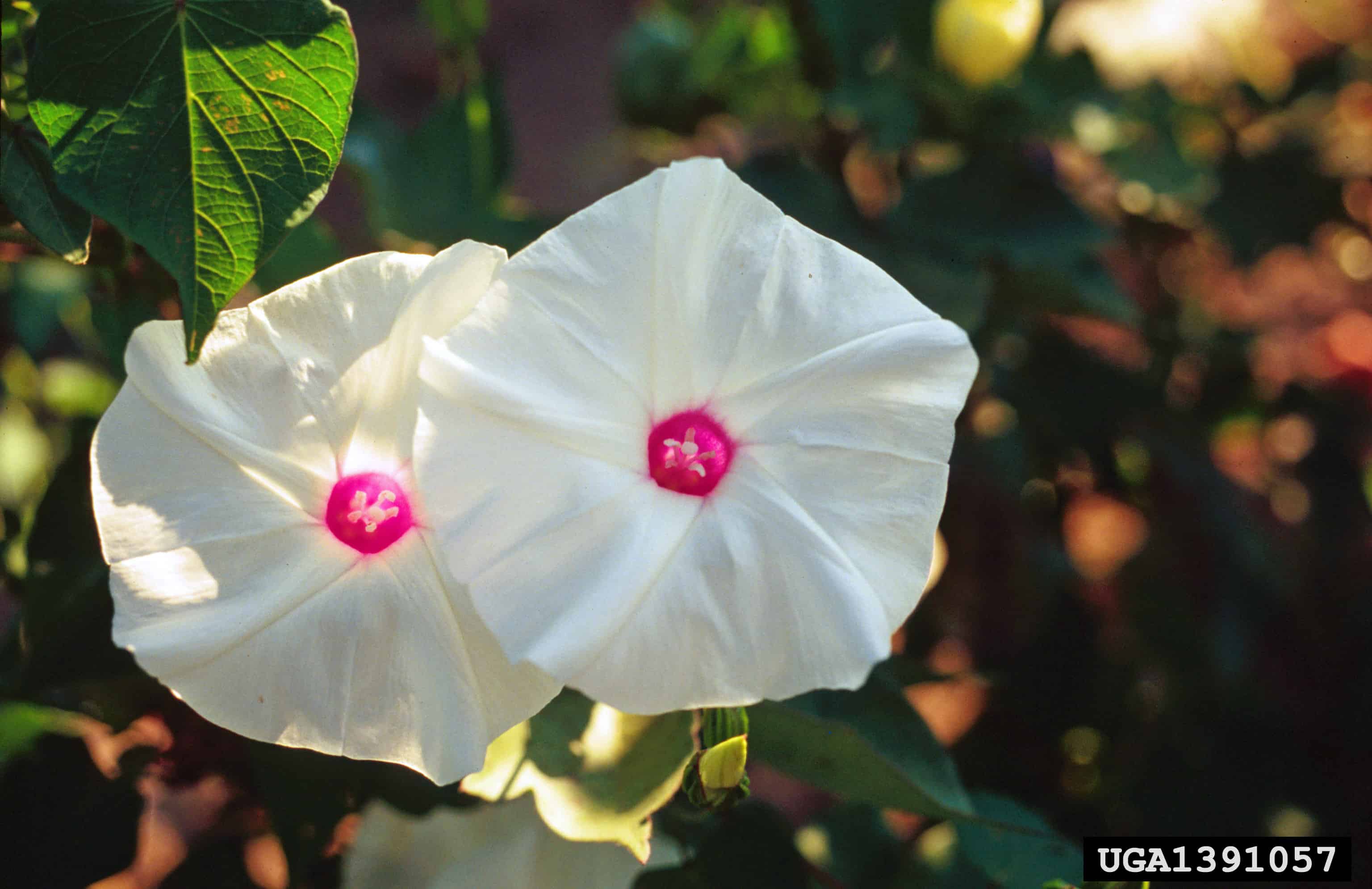Ipomoea pandurata
Explore More :
Explore plus :
Overview
Aperçu
Regulation :
Remarques Réglementation:
- Quarantine lists of countries e.g. China *may be updated without notice
Regulation Notes:
On quarantine lists of countries e.g. China*.
*Quarantine lists of countries may be updated without notice.
Distribution :
Répartition :
This species is native to central and eastern North America, extending northwards to ON (USDA-ARS 2017; USDA-NRCS 2017).
Habitat and Crop Association :
Habitat et Cultures Associées :
Bigroot morning-glory can be found in dry woods and thickets, streambanks, fencerows, abandoned fields, railroads, roadsides and other disturbed areas (Gleason and Cronquist 1991; Hilty 2017). It prefers dry, open or partly shaded soil (Scoggan 1979).
Economic Use, cultivation area, and Weed Association :
Utilisation économique, zone de culture et association de mauvaises herbes :
Duration of Life Cycle :
Durée du cycle vital:
Perennial
Dispersal Unit Type :
Type d’unité de dispersion :
Seed
General Information
RENSEIGNEMENTS GÉNÉRAUX
Bigroot morning-glory is a twining vine with a large, tuber-like root (Gleason and Cronquist 1991). It is sometimes cultivated but can escape and smother surrounding vegetation (Hilty 2017). In Canada it is present only in southern ON but is extremely rare (Newmaster and Ragupathy 2012).
.
Field of Ipomoea pandurata (Charles T. Bryson, USDA Agricultural Research Service, Bugwood.org)
Identification
Identification
-
Seed
Size
- Seed length: 4.2 – 6.4 mm (average: 5.1 mm) ; width: 2.7 – 4.4 mm (average: 3.5 mm)
Shape
- Seed resting on its curved side is oval to egg-shaped in outline while it is a sectoroid shape in 3 dimensional view
- Seed resting on a flat side has a narrow D-shape
Surface Texture
- Seed surface is smooth with slight stippling under magnification
- Conspicuous long hairs along the seed margins form a fringe
Colour
- Seeds are dull and reddish brown to dark brown, occasionally light brown
- The fringe of hairs is brown
Other Features
- One side of the seed has a horse shoe-shaped notch at one end where hilum is located
- Worn seeds may lack an obvious fringe of hairs

Bigroot morning-glory (Ipomoea pandurata) seeds






Identification Tips
CONSEILS POUR L’IDENTIFICATION
Additional Botany Information
AUTRES RENSEIGNEMENTS BOTANIQUES

Ipomoea pandurata flowers (John D. Byrd, Mississippi State University, Bugwood.org)




Similar Species
ESPÈCES SEMBLABLES
Similar species are based on a study of seed morphology of various species, and those with similar dispersal units are identified. The study is limited by physical specimen and literature availability at the time of examination, and possibly impacted by the subjectivity of the authors based on their knowledge and experience. Providing similar species information for seed identification is to make users aware of similarities that could possibly result in misidentification.
Ipomoea aquatica (Swamp morning-glory)
Ipomoea aquatica seeds are similar in size, colour, shape, horseshoe-shaped hilum, and slight stippling as bigroot morning-glory.
Ipomoea aquatica seeds are generally wider (average width: 4.0 mm), the surfaces are smooth or covered with short, yellowish brown hairs that are longer around the hilum. The seeds lack the long fringe of hairs seen in bigroot morning-glory.
Click to select species
Cliquez pour sélectionner les espèces

Ipomoea aquatica
Comparison Window
Fenêtre de comparaison
MAIN SPECIES
ESPÈCES PRINCIPALES
Ipomoea pandurata

Ipomoea pandurata
Convolvulaceae
Bigroot morning-glory (Ipomoea pandurata) seeds
MAIN SPECIES
ESPÈCES PRINCIPALES
Ipomoea pandurata

Ipomoea pandurata
Convolvulaceae
Bigroot morning-glory (Ipomoea pandurata) seeds
MAIN SPECIES
ESPÈCES PRINCIPALES
Ipomoea pandurata

Ipomoea pandurata
Convolvulaceae
Bigroot morning-glory (Ipomoea pandurata) seed
MAIN SPECIES
ESPÈCES PRINCIPALES
Ipomoea pandurata

Ipomoea pandurata
Convolvulaceae
Ipomoea pandurata seed
MAIN SPECIES
ESPÈCES PRINCIPALES
Ipomoea pandurata

Ipomoea pandurata
Convolvulaceae
Bigroot morning-glory (Ipomoea pandurata) seed; side view
MAIN SPECIES
ESPÈCES PRINCIPALES
Ipomoea pandurata

Ipomoea pandurata
Convolvulaceae
Bigroot morning-glory (Ipomoea pandurata) seed; hilum (close up view)
SIMILAR SPECIES
ESPÈCES SEMBLABLES
Ipomoea aquatica

Ipomoea aquatica
Convolvulaceae
Ipomoea aquatica seeds
SIMILAR SPECIES
ESPÈCES SEMBLABLES
Ipomoea aquatica

Ipomoea aquatica
Convolvulaceae
Ipomoea aquatica seeds
SIMILAR SPECIES
ESPÈCES SEMBLABLES
Ipomoea aquatica

Ipomoea aquatica
Convolvulaceae
Ipomoea aquatica seed
SIMILAR SPECIES
ESPÈCES SEMBLABLES
Ipomoea aquatica

Ipomoea aquatica
Convolvulaceae
Ipomoea aquatica seed; hilum (close-up view)
Need ID Help?
Besoin d’aide pour l’identification?
Reference(s)
Référence(s)
Global Biodiversity Information Facility (GBIF) Secretariat. 2022. https://doi.org/10.15468/39omei Accessed via https://www.gbif.org/species/2928514 Accessed December 29, 2022.
Gleason, H. A. and Cronquist, A. 1991. Manual of Vascular Plants of Northeastern United States and Adjacent Canada. Second Edition. The New York Botanical Garden, Bronx, New York. 993 pp.
Hilty, D.J. 2017. Illinois Wild Flowers, http://www.illinoiswildflowers.info Accessed April 25, 2017.
Newmaster, S. G. and Ragupathy, S. 2012. Flora Ontario – Integrated Botanical Information System (FOIBIS), Phase I. University of Guelph, Guelph, ON, http://www.uoguelph.ca/foibis/ Accessed July 25, 2017.
Scoggan, H. J. 1979. Flora of Canada. National Museums of Canada, Ottawa, Canada. 4 vols. 1711 pp.
U.S. Department of Agriculture-Agricultural Research Services (USDA-ARS). 2017. Germplasm Resources Information Network (GRIN), https://npgsweb.ars-grin.gov/gringlobal/taxon/taxonomysearch Accessed April 25, 2017.
U.S. Department of Agriculture-Natural Resources Conservation Service (USDA-NRCS). 2017. The PLANTS Database. National Plant Data Team, Greensboro, NC USA. https://plants.usda.gov/home Accessed April 25, 2017.
U.S. Department of Agriculture-Natural Resources Conservation Service (USDA-NRCS). 2022. The PLANTS Database. National Plant Data Team, Greensboro, NC USA. http://plants.usda.gov Accessed December 29, 2022.




